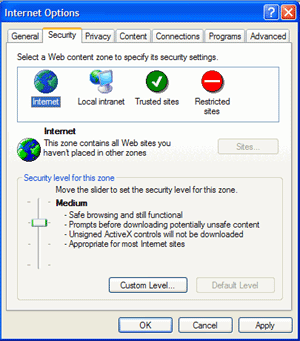If you've read some of our
other articles such as our guide to
spyware and
adware or our Internet security
article . You'll know that the Windows
registry is one of the most common targets of attack for malicious software.
Once access to your registry is gained, these programs can do virtually
anything, from perpetually reinstalling themselves (as many browser hijacking
programs and spyware are wont to do) to rendering your system
unbootable.
Fortunately there are several
steps you can take to protect your registry from outside interference. Let's run
through a few of them:
Internet settings:
Since the Internet is by far
the most common vector for registry-threatening attacks, it makes sense that the
first line of defence is to strengthen the security of your web browser. Let's
look at a few changes to make Internet Explorer more secure.
Open Internet Explorer and go
to 'tools\Internet options.' Click on the 'security' tab. First, ensure that the
'internet' zone is selected at the top, then click on the 'default level' button
(if it is not already activated) and set the slider to 'medium.' The medium
security level of Internet Explorer is mostly secure, but there are a few
additional things we need to change.

Now click the 'custom level'
button. Scroll down to the 'navigate sub-frames for different domains' setting
and change it to 'prompt.' Hit 'ok' and confirm the changes.
Now click the 'content' tab.
If there are any entries here that you do not recognize, remove them. In fact,
it's a good idea to remove all entries here as a matter of course. Anyone or any
company with an entry here will be able to install software onto your system
without requiring permission from a user.

